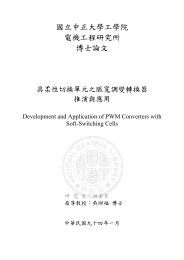Syntax of the Bi Comparative Construction in Mandarin Chinese
Syntax of the Bi Comparative Construction in Mandarin Chinese
Syntax of the Bi Comparative Construction in Mandarin Chinese
You also want an ePaper? Increase the reach of your titles
YUMPU automatically turns print PDFs into web optimized ePapers that Google loves.
<strong>Syntax</strong> <strong>of</strong> <strong>the</strong> <strong>Bi</strong> <strong>Comparative</strong> <strong>Construction</strong> <strong>in</strong> Mandar<strong>in</strong> Ch<strong>in</strong>ese<br />
b. wo [CPbi Lisi ai ni] geng ai ni<br />
I COM Lisi love you more love you<br />
Note that, accord<strong>in</strong>g to Her (2006), MC complementizers such as gei and shuo<br />
needs to be licensed and thus cannot stand alone, <strong>the</strong> comparative marker bi is not an<br />
exception. The comparative bi-clause occurs only with gradable phrases that are<br />
modified by <strong>the</strong> degree adverb geng. The complementizer determ<strong>in</strong>es <strong>the</strong> type <strong>of</strong> IP<br />
which it <strong>in</strong>troduces. English that selects f<strong>in</strong>ite clauses and English for selects<br />
<strong>in</strong>f<strong>in</strong>itival clauses (Hageman 1997:53), similarly bi <strong>in</strong> MC selects gradable<br />
comparative clauses.<br />
In <strong>the</strong> follow<strong>in</strong>g section 3.3, we are go<strong>in</strong>g to f<strong>in</strong>d out more evidence to support<br />
<strong>the</strong> hypo<strong>the</strong>sis that bi and geng has co-occurrence restriction and ma<strong>in</strong>ta<strong>in</strong> <strong>the</strong><br />
necessity <strong>of</strong> geng <strong>in</strong> BCC.<br />
3.3 The Syntactic Status <strong>of</strong> <strong>the</strong> Degree adverb- geng 13<br />
Gradable predicates can <strong>in</strong>clude nom<strong>in</strong>al, adjectival, and verbal predicates (Sapir<br />
1944, Bol<strong>in</strong>ger 1972) <strong>in</strong> (103), it is <strong>the</strong> gradable feature that makes <strong>the</strong> clauses<br />
comparable. In this section, we are go<strong>in</strong>g to propose that though <strong>the</strong> comparative<br />
degree adverb geng is <strong>of</strong>ten covert <strong>in</strong> <strong>the</strong> PF, it is actually <strong>the</strong> head <strong>of</strong> <strong>the</strong> comparative<br />
DegP that assign feature to <strong>the</strong> comparative bi-clauses.<br />
13 Besides geng, <strong>the</strong> comparative degree adverbs can also have its alternations haiyao/ hai, ‘more,’ for<br />
some phonological or pragmatic reason; <strong>the</strong>y cannot alternate for each o<strong>the</strong>r <strong>in</strong> some cases, and<br />
sometimes even both <strong>of</strong> <strong>the</strong>m can be covert. Phonologically, <strong>the</strong> stress on geng is heavier than haiyao/<br />
hai, so we hopo<strong>the</strong>size that <strong>the</strong> degree <strong>of</strong> emphatic mean<strong>in</strong>g on <strong>the</strong>se alternative comparavie degree<br />
adverbs are geng >haiyao/ hai>φ. Yet, geng seems to occur <strong>in</strong> most cases, we take geng as <strong>the</strong><br />
representitive <strong>of</strong> <strong>the</strong> comparative degree adverb.<br />
(i) a. wo bi Lisi (geng/haiyao) gao<br />
I COM Lisi more tall<br />
‘I am taller than Lisi.’<br />
b. wo bi Lisi (*geng)/(haiyao) gao san gongfen<br />
I COM Lisi more tall three centimeter<br />
‘I am three centimeters taller than Lisi is.’<br />
61<br />
中正大學 e-Thesys (94 學年度)





